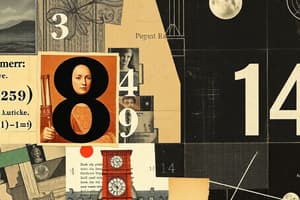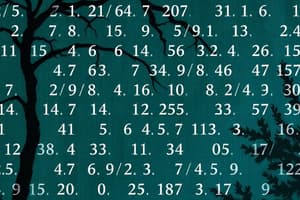Podcast
Questions and Answers
Which of the following sets of numbers does NOT include rational numbers?
Which of the following sets of numbers does NOT include rational numbers?
- Whole Numbers
- Integers
- Natural Numbers
- Irrational Numbers (correct)
What is a defining characteristic of rational numbers?
What is a defining characteristic of rational numbers?
- They must be integers.
- They can be expressed as a terminating decimal. (correct)
- They can be written as a fraction where the denominator is zero.
- They cannot be expressed as the ratio of two integers.
Which of the following numbers is NOT a rational number?
Which of the following numbers is NOT a rational number?
- -8
- √2 (correct)
- 3/4
- 1.5
Which of these fractions can be categorized as a rational number?
Which of these fractions can be categorized as a rational number?
What type of number comprises both rational and irrational numbers?
What type of number comprises both rational and irrational numbers?
Which of these best illustrates the relationship between the different sets of numbers?
Which of these best illustrates the relationship between the different sets of numbers?
Which of these decimal representations indicates a rational number?
Which of these decimal representations indicates a rational number?
What happens when a rational number is expressed as a decimal?
What happens when a rational number is expressed as a decimal?
Which method can be used to compare fractions with the same denominator?
Which method can be used to compare fractions with the same denominator?
What is the larger fraction between $\frac{2}{5}$ and $\frac{3}{8}$?
What is the larger fraction between $\frac{2}{5}$ and $\frac{3}{8}$?
Which of the following rational numbers is the largest?
Which of the following rational numbers is the largest?
When comparing $\frac{7}{9}$ and $\frac{8}{8}$, what symbol should be placed between them?
When comparing $\frac{7}{9}$ and $\frac{8}{8}$, what symbol should be placed between them?
Flashcards are hidden until you start studying
Study Notes
Rational Numbers Overview
- Rational numbers can be expressed as fractions where both the numerator (𝑎) and denominator (𝑏) are integers, with 𝑏 ≠ 0.
- Examples of rational numbers include 2, -4, 0.5, and 3.
Number Sets
- Natural Numbers (ℕ): Counting numbers {1, 2, 3, 4, …}.
- Whole Numbers (𝕎): Natural numbers including zero {0, 1, 2, 3, 4, …}.
- Integers (𝕀): Positive and negative whole numbers {…, -3, -2, -1, 0, 1, 2, 3, …}.
- Irrational Numbers (ℚ̅): Cannot be expressed as fractions; non-terminating, non-repeating decimals. Examples include 𝜋 and √2.
- Real Numbers (ℝ): The complete set of rational and irrational numbers.
Characteristics of Rational Numbers
- Includes integers, fractions, terminating decimals, and repeating decimals.
- Visual representation can be illustrated using a Venn diagram to show the inclusion of various number sets.
Comparing and Ordering Numbers
- Comparing Decimals: Use place value to determine which number is larger (e.g., 9.25 vs. 9.7).
- Comparing Fractions:
- Common Denominators: If fractions share a denominator, the larger numerator indicates the larger fraction.
- Common Numerators: If fractions share a positive numerator, the smaller denominator indicates the larger fraction.
- Number Line: Use benchmarks to arrange fractions in order.
Examples of Rational Number Comparisons
- Example of Ordering: Arrange the following fractions and decimals in descending order: −3, 0.5, −1.8, −5, 3/4, 2, −3.3̅, 1.
- Greater than, Less than or Equal To: Using symbols (> , <, =) to compare rational numbers.
Additional Comparisons and Identifications
- The position of negative signs does not affect comparisons involving absolute values.
- Decimal identification: Find decimal numbers between given rational numbers, such as between −1 and 2 or −1 and 4.
Practical Exercises
- Create three different fractions from any two integers and convert each to decimal.
- Classify which numbers are rational from a given set (e.g., √9, 0.25, √75, π).
Studying That Suits You
Use AI to generate personalized quizzes and flashcards to suit your learning preferences.




